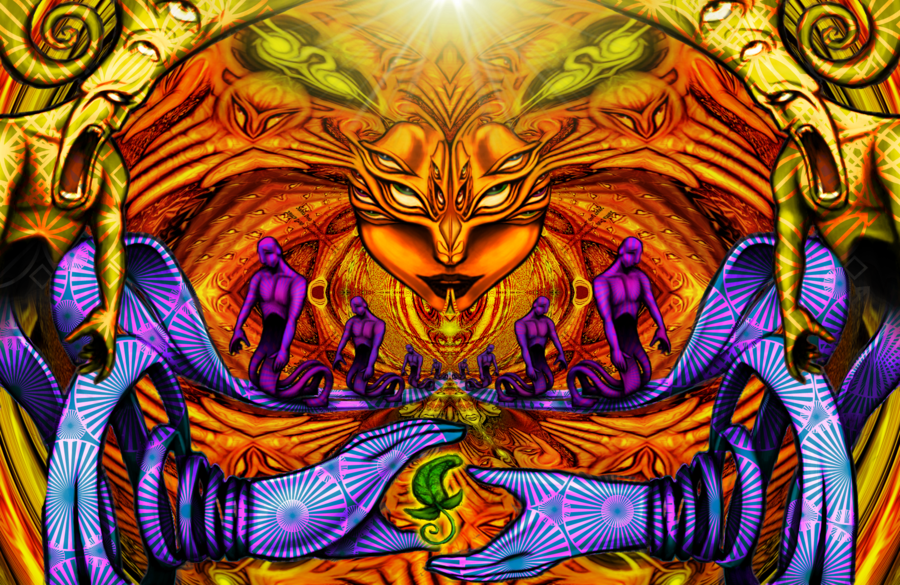Reality – from a pragmatic point of view – may be said to be divided into two distinct domains – the domain of structure and the domain of essence. ‘Structure’ is how things are organized, and the rules and regulations that go with this, whilst ‘essence’ (we may say) is what is being organized or regulated. We could also speak of these two realms as the realm of content and the realm of consciousness. Having made this distinction, we can go on to say that our perception of the world is conditioned only to register the level of organization, the level of rules. Essence is both invisible and inconceivable to us, just as ‘free consciousness’ is something that just doesn’t appear for us in our dictionary of ‘things’. We understand consciousness only when it is caught up with form or content, only when it is in its ‘attached’ mode, so to speak. So if we say that essence is organized into structure then the structure is all we ever deal with – we never ever look beyond it. We’re not actually interested in looking beyond it – ‘content’ (or ‘structure’) is all that we care about!
An illustration of what we’re talking about here would be a length of string that has been arranged into various shapes. We’re interested in shapes – we put an awful lot of stock in them – but we can’t for the life of us see the string that the shapes are made up of. We can’t see the string, and what is more, we aren’t in the least bit interested in seeing it! We aren’t interested in seeing the string precisely because we’re we have put so much stock in the shapes that it has been arranged into. To see the string is to be no longer able to believe in the ‘final reality’ of the shapes and we are very much invested in believing in the shapes as ‘a final reality’. The domain of structure is the only domain we know about – it’s the whole world to us – and so, naturally enough, we have gone ahead and invested everything we have in it. We have hung everything we’ve got on the hook of ‘the domain of structure’ and so we’re not particularly keen on finding out, at this late stage in the proceedings, that the hook in question doesn’t actually have any final existence.
There is a very big problem indeed with investing everything we’ve got in the domain of structure (or the domain of ‘defined content’) therefore. Even if we ignore the fundamental problem that the hook we’re hanging everything on doesn’t exist (i.e. the fundamental problem of it being a ‘sky-hook’ rather than being a proper solid old-fashioned type of a hook that is fixed reliably onto the wall) we still have what we might call ‘the problem of compulsory superficiality’ – we are compelled in this world to be superficial in all things because if we aren’t then we run the risk of ‘seeing beyond the shapes’ and this – of course – would open up a whole big can of worms! We can’t afford to see beyond the world of structure (because of the game that we’re playing) and so we absolutely have to ‘keep in superficial’. We have to play dumb as convincingly as possible in other words; we have to play dumb and believe the act that we are putting on to the limit of our ability- this is what Chogyam Trungpa refers to as the game of ‘intelligent stupidity’ – we’re being stupid but in a clever or calculated way!
The thing about living in the domain of structure (or ‘form’) is however that there is no real ‘sustenance’ to it – all the food we eat is made of cardboard, so to speak. The world of structure is a sterile one. It is sterile for the simple reason that reality has been excluded – what’s real in the world of structure is ‘the string’ not ‘the shapes’ and the string happens to be the one thing that we’re not allowed to see. We’re not allowed to see the one thing that’s actually real, so where does this leave us? We are compelled to make do with the unreal instead of the real and the unreal is completely lacking in any nourishing qualities – naturally enough! It has no taste, no small, no nutritional content and so all it can do is tantalize. The domain of structure is another way of talking about hyperreality therefore – instead of relating to actual food we have to make do with high-resolution photos of what we are supposedly going to eat, what is supposedly available for us to eat. Instead of friends we have to make do with cardboard cut-outs, glossy images of people looking good and having fun that have been uploaded onto a social media site…
If we were to sit down and try to invent a nightmare we couldn’t do any better than this; when we have identified completely with the domain of structure then we are ‘identified with the unreal’. We can’t ever look too deeply into ourselves (or the virtual world which we live in) or else the unreality will start to show. Living compulsorily on such a superficial level necessarily engenders fears and insecurities – we are trading on something that doesn’t exist, after all, so how confident can we really be? At the core of everything there is this dreadful hollowness and this hollow core of ours (which we can never admit to) sends out ‘shock waves’ that impinge upon our day-to-day consciousness and cause us to feel bad in a way that we’re not allowed to acknowledge. The feelings have to be disowned because if we don’t disown them then that will straightaway give the game away. We attribute the feelings elsewhere therefore – we lay them at the door of whatever it is that happens to be going on in our life at the time. ‘He did this’, or ‘she said that’, we might say; things happened that ‘shouldn’t have happened’ and so that’s why we feel so bad.
Instead of acknowledging our insecurity, acknowledging our existential pain (which has nothing to do with the particularities of whatever situation we are finding ourselves in but everything to do with the fact that we our denying our essential being) we adopt a plethora of coping strategies, we engage in a wide range of tried-and-trusted pain-displacement techniques. These pain-displacement techniques (or self-distraction strategies) become pretty much ‘what we do in life’; they become ‘life itself’ as far as we are concerned whilst the real thing gets completely forgotten about. Our actual life becomes a stranger to us, an alien reality, something that we simply have no way of relating to. This may seem like a rather extreme or far-fetched kind of a statement to be making but it is nothing of the sort – all we need to do in order to appreciate the truth of what we have just said is to consider the fact that most of our life is conducted on the basis of that construct generally known as ‘the ego’ (which is, by any standards, a fairly uncontroversial way of looking at things). This being the case (as most of us would agree that it is) how can we deny that most of our daily activity is about assuaging the insecurities of this ‘false sense of self’? What else does the ego ever get to do anyway, other than seeking to assuage its insecurities? What else would it ever care about? We can’t be so psychologically naive as to imagine that it might have other interests…
This situation of ours is a very strange one therefore – the thing that motivates us most in life is the need to compensate for the painful insecurities that unfailingly come about as a result of us pretending so very thoroughly to be who we’re not. Acting as if we are this ego sets us up to feel all this insecurity/existential pain and our need to avoid the unbearable sting of this pain impels us to throw ourselves into the act all the more since ‘throwing ourselves into the act’ is how we avoid the pain, as well as being how we create it in the first place! The ego validates itself with all its ‘self-assertion type’ activities, and the more it validates itself the more real it becomes to itself (which is of course the whole point of the exercise) and then the more real the ego becomes to itself to itself the more cut off we are from our essential nature and so the more we need to validate and reaffirm our (conditioned) existence with egoic-type activities. This – which is what Alan Watts calls ‘the vicious circle’. In one Sufi tale of Jesus (taken from The Sufi mystery, Ed Nathaniel P. Archer) the following unfamiliar parable is recounted:
Jesus said: Whoever loves this world is like the man who drinks sea-water. The more he drinks, the thirstier he becomes, until in the end he dies, and still his thirst has not been assuaged.
As a culture, we very much understand ourselves in terms of ‘structure’ rather than ‘indefinable essence’. It is hardly necessary to say this – all we need to do is to take a look into the pages of any textbook on psychology to see this. What we see is ‘the language of structure’ rather than ‘the language of essence’ (or, as we might also say, ‘the language of spirit’). Such is the age we live in and no one is likely even to try to deny this; the question isn’t whether we deny it but whether we see this as being a good thing or not and most of us would undoubtedly say that it is a clear sign of our advancement over older civilizations that we have adopted an exclusively rational/logical way of describing ourselves and our affairs rather than using a much more obscure (and much less black-and-white) ‘poetical-mystical’ idiom. We do our utmost, with the greatest possible degree of verifiable rigour, to define ourselves completely within the terms of logic and rationality. We do our damndest. We really do throw ourselves into the task of rationalizing everything’ with everything we’ve got. And yet why would we even want to? Why would be so inordinately keen to ‘explain ourselves away’?
Concomitant with our never-ending struggle to rationally define ourselves (which is to say, within the terms of what we have called structure) is the equally never-ending struggle to solve the problem of the neurotic pain that we are experiencing as a result of being so tightly defined, and so here again we come face to face with this same old glitch, this same old knot, this same old vicious circle. Only this time it’s been ratcheted a good few notches and put into another gear entirely. The basic everyday ‘knot’ that just about every human being on the planet is caught up in (the knot which is the result of us reacting to the pain that has been caused us being separated from our essential nature by strategizing and scheming in an attempt to slip free of the noose, and ensnaring us in it all the more thereby) is one thing, and it has been with us throughout the whole of human history, but when we as a strictly rational-logical culture officially designate ourselves as being ‘complicated structures and nothing more’ and then try to treat the result feelings of meaninglessness and alienation with all our various psychological techniques and methods, all of which have been developed in the most stringently ‘scientific’ manner and presented as being ‘evidence-based’ (which means that we are obliged to unquestioningly accept them as valid even though they clearly aren’t) then we have entered into a whole new realm of enhanced foolishness. We have become ‘technically clever and highly-resourced fools’ and this is of course the most dangerous type of fool there is!
There’s no such thing as ‘an evidence-based’ way of solving the neurotic suffering that we have inflicted upon ourselves as a result of us opting to live in the domain of structure (or the domain of reason) as if this were the only world there is! What we have just described here is a glitch, a knot. Evidence is what it takes to convince us, we say, because without evidence nothing is proved, nothing is certain. Yet all we’re really doing here is moving even further into the realm of rationality, since it is the disassociated rational mind which requires ‘evidence’ not the core of who we are! Wise people do not live their lives on the basis of so-called ‘scientific evidence’ – only fools try to do this. The wise live their lives on the basis of their own wisdom, their own intuition, their own insight, and do not demand to have logical proof (produced by men in white coats) that this is the best way to do things! There’s no evidence to tell us how to resolve the neurosis that we are culturally afflicted with, just as there is no evidence to tell us ‘how to live life’! The two are the same thing. Instead of looking outside of ourselves, we have to look within, and this is the ‘wisdom of the ages’, the wisdom which we modern folk are so determined to ignore! We would rather rule over a hollow kingdom than relinquish our pointless cleverness and inherit the Kingdom of God, as the old-fashioned language has it…
Art: ‘City’ by Katy Hirschfeld







Rashid Dossett
Worldly people are obsessed with external validation by society. In the post-modern western culture this obsession with self-validation is channeled through what we consider “scientific evidence”. It is – in many cases – not about whether something is true or proven. It is only about what is considered and validated as real by the group.
This hollow kingdom which you speak about is a construct that can only remain in existence due to individual and collective denial. So, it comes down to that worldly people negate life itself instead of embracing it and living it to the full (with a very few exceptions).